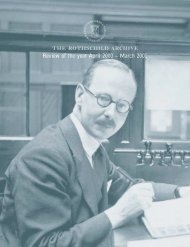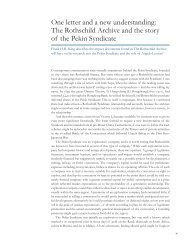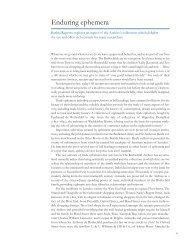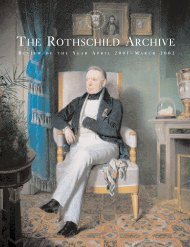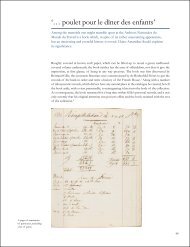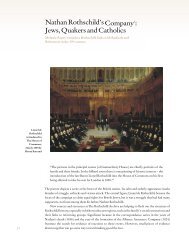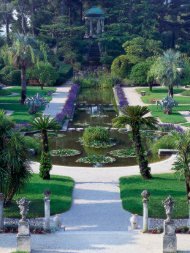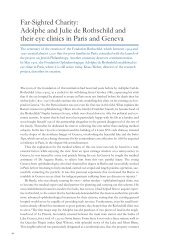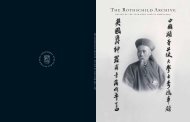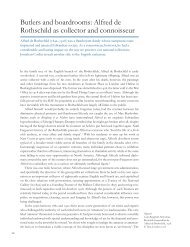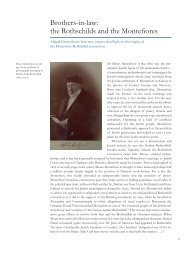66900 Rothschild Archive - The Rothschild Archive.
66900 Rothschild Archive - The Rothschild Archive.
66900 Rothschild Archive - The Rothschild Archive.
You also want an ePaper? Increase the reach of your titles
YUMPU automatically turns print PDFs into web optimized ePapers that Google loves.
<strong>The</strong> colours of another world<br />
As we approach the centenary in 2007 of the first commercially viable process for<br />
colour photography, Victor Gray describes the Autochrome photographs of Lionel<br />
de <strong>Rothschild</strong> (1882–1942)<br />
<strong>The</strong> regular meeting of the Royal Photographic Society on 5 November 1907 broke all records<br />
for attendance. ‘<strong>The</strong> society was almost unable to cope, what with the crowd that besieged its<br />
doors’, reported <strong>The</strong> Amateur Photographer. Mr T.K. Grant, ₁ the lecturer for the evening, held his<br />
audience as rapt as any magician. He had brought with him a single glass photographic plate<br />
which he proceeded to dip and wash with chemicals and varnish and dry and finally to put in a<br />
lantern projector. <strong>The</strong>re, on the screen, appeared the image of a bowl of flowers standing<br />
before a window. But unlike any photographic image this audience had seen before, these were<br />
flowers in colour, a colour that was soft and subtle and surprising, a colour that seemed true to<br />
life in a way that they felt they had only seen before in the work of artists. <strong>The</strong>y had witnessed<br />
the Autochrome coming to life.<br />
Part of the reason for the packed audience was the build-up of tension that surrounded the<br />
launch in Britain of the Autochrome. <strong>The</strong> invention of the French Lumière brothers, the<br />
process had first been described by them in theoretical terms three years before and demonstrated<br />
publicly in Paris in June 1907. <strong>The</strong> unexpected rush of orders which followed in France<br />
led to problems of supply and the first plates for sale did not reach Britain until September. <strong>The</strong><br />
delay was long enough for rumours to blossom of the miraculous quality of the images and<br />
excitement to grow feverishly. For this was the first commercially viable colour photographic<br />
process, bringing colour photography within the grasp of the amateur (albeit a well-heeled amateur,<br />
for this was no cheap product).<br />
It is hard, a hundred years on, to recapture the astonishment of that audience at seeing their<br />
world reproduced so faithfully on a screen in a darkened room, bringing together the sharp eye<br />
of the camera lens with the palette of the painter. Photography, despite nearly sixty years of<br />
experiments with colour, had remained, for all but the isolated professional, a monochromatic<br />
achievement, and colour reproduction in books had generally enlivened the page rather than<br />
captured the true colours of its subjects. Now their world – their colour-full world – had been<br />
captured and reflected back to them as they had never before seen it.<br />
It was a good time to be young and in love with the new. Wireless signals had crossed the<br />
Atlantic in 1901. Moving pictures were being shown in cinemas across the country. <strong>The</strong> speed<br />
limit for the growing number of motor cars had been raised to 20 m.p.h. in 1903. <strong>The</strong> Wright<br />
Brothers were developing their powered flying engines and would, within months, make their<br />
first public demonstration.<br />
Lionel de <strong>Rothschild</strong> was young in that time and shared in the passion for the new. He was<br />
born on 25 January 1882, the son of Leopold de <strong>Rothschild</strong> who was one of the three partnerbrothers<br />
in the business of N.M. <strong>Rothschild</strong> & Sons, one of the most powerful international<br />
financial forces of the time, then at the height of its fortunes. His course had been set for him<br />
from birth. Harrow and Trinity led inevitably to the door of New Court, the family banking<br />
house, and to New Court he duly went at the age of 21, in 1903. He stayed there for the rest of<br />
his life, becoming a full partner in 1915 until his death in 1942.<br />
But away from New Court, Lionel played fully the part of a young man of fortune let loose<br />
on an exciting world. He had first acquired a motor vehicle at Cambridge and, once bitten,<br />
longed for bigger and better. Thwarted by an anxious father in his attempts to compete in<br />
14



